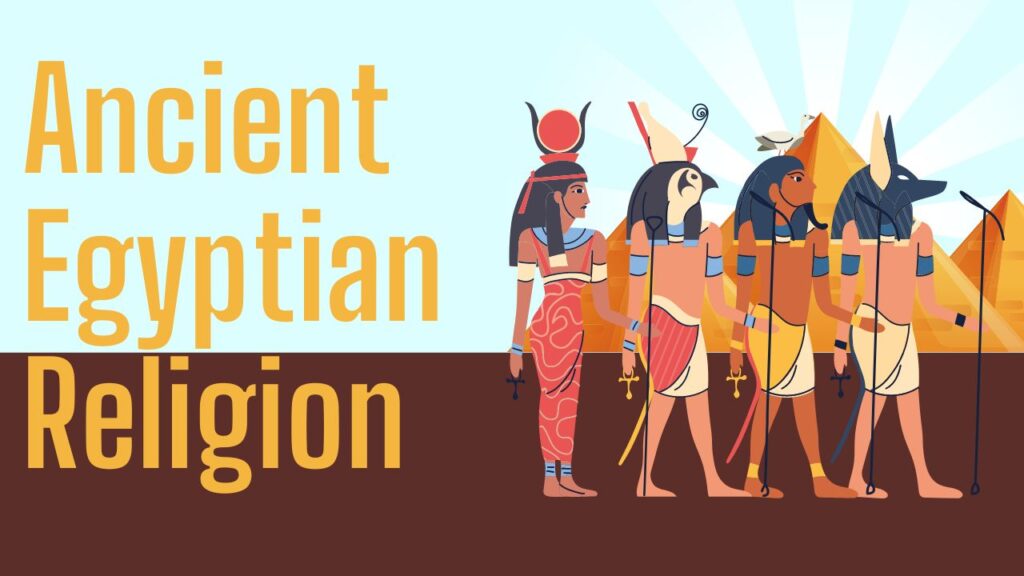Ancient Egyptian Religion Ancient Egypt, an 8,000+ year-old civilization which flourished 4,000+ years ago along the Nile River, was known for its stunning pyramids, intricate mythology and profound religious beliefs which had such an enormous effect on Egyptian society as whole. Here we examine this vibrant religion further by unveiling all of its key aspects and significance.

Contents
Ancient Egyptian Religion: The Foundation of Life
The Divine Pantheon: Gods and Goddesses of Ancient Egypt
Ancient Egyptians were deeply religious people. Their vast pantheon of gods and goddesses represented various aspects of life, nature and cosmos – among the more prominent being Ra, sun god; Isis mother goddess with magical abilities; Osiris afterlife/resurrection Lord and Anubis mummification Gods.
Beliefs and Rituals: The Intersection of Daily Life and Religion
Ancient Egyptian religion pervaded every aspect of society. Egyptians believed in an afterlife where souls would journey towards Ma’at for judgement; therefore elaborate burial rites like mummification were performed to facilitate passage to this realm. Temples were constructed to worship their gods while religious services held regularly were designed to receive divine favour from heaven and gain divine blessings or favour from him.
The Influence of Religion on Art and Architecture
Sacred Monuments: Pyramids, Temples, and Obelisks
Ancient Egyptian architecture stands as testimony of their religious devotion: Giza’s Great Pyramid stands as testament, serving as tombs for Pharaohs; temples with intricate carvings and hieroglyphics dedicate themselves to specific deities for worship and religious ceremonies; iconic Obelisks even serve as symbols representing sun god Ra.
Divine Depictions: Art and Symbolism
Ancient Egyptian art was rich with religious symbolism. Pharaohs often took on divine attributes while their gods and goddesses often featured both human bodies and animal features. Hieroglyphics was an early way of using symbols as writing systems which preserved myths and beliefs of this ancient culture.
The Legacy of Ancient Egyptian Religion
Enduring Impact: Religion in Afterlife Beliefs
Though ancient Egyptian religion declined with Christianity and Islam’s rise, its legacy lives on in various beliefs and practices of later religions – afterlife beliefs can still be found today, while Isis remains highly esteemed amongst believers today.
Archaeological Discoveries: Unlocking Ancient Secrets
Archeologists and historians continue their exploration of Ancient Egyptian religion with archaeologists uncovering more artefacts related to Egyptian practices and beliefs, providing invaluable insight into its culture and spirituality.
Here is a list of famous 10 ancient Egyptian gods & goddesses:
1. Amun “The Creator God”
2. Ra (Atum) “God of Sun”
3. Osiris “God of Justice”
4. Isis “Goddess of Motherhood”
5. Hathor “Goddess of Drunkenness”
6. Ma’at “Goddess of Balance”
7. Horus “God of Sky”
8. Anubis “God of Death”
9. Set “God of Deception” 1
0. Nephthys “Goddess of Funerals”
Conclusion
Ancient Egyptian religion was an intricate, dynamic system which has had profound ramifications on its people for millennia. From worshipping gods and goddesses to building magnificent monuments, religion pervaded every aspect of Egyptian society – its legacy continues to amaze audiences worldwide as evidence of how deeply connected ancient Egyptians felt spiritually with both gods and afterlife.
Related Post :
The Timeline of Human Mythology and Religion
How Did People Bring Religion West With Them Exploring the 5 Powerful Ways Religion Journeyed West
References:









